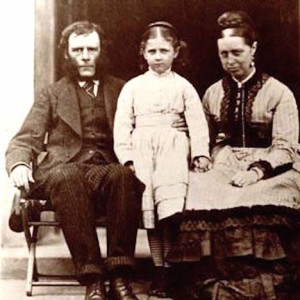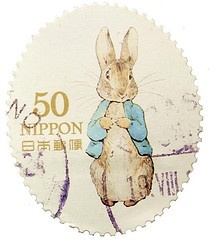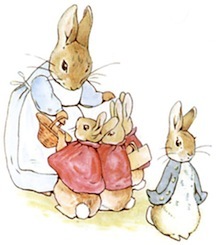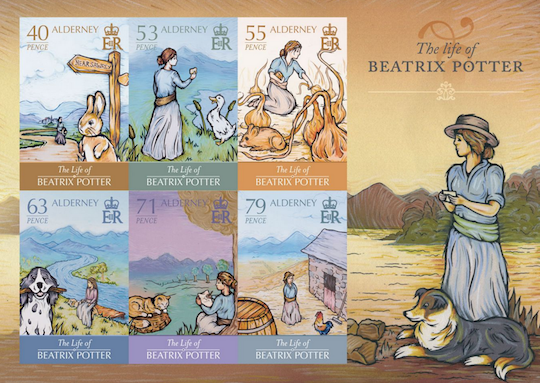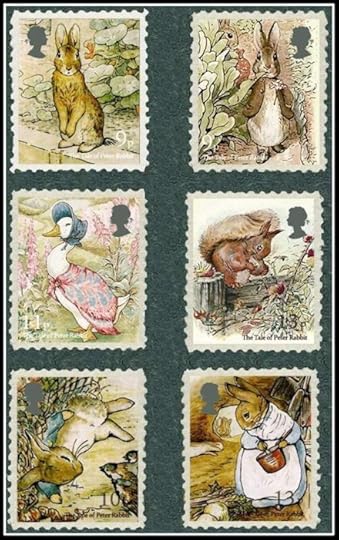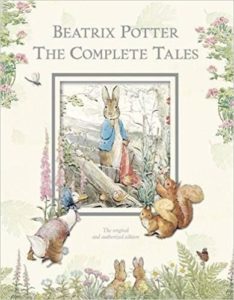Beatrix Potter
Beatrix Potter (July 28, 1866 – December 22, 1943) was a British author and illustrator of beloved children’s books. Her inspiration came from the nature and animals that surrounded her as a child and sprouted an imagination that would delight the world forever.
Beatrix was the daughter of a stuffy, wealthy, conservative couple who cared only about appearance and social status. They cared little for their daughter, and yet, constricted her activities as much as possible so that she had little contact with the world outside their South Kensington mansion and grounds. She wasn’t even allowed to school, nor have any friends her own age. For much of her childhood, her only friend and companion was her brother, Bertram, who was six years younger than she.
An early fascination with the natural world
And so, even though this childhood of isolation and being raised by strict nurses and governesses couldn’t have been easy, Beatrix’s loneliness fueled her fascination with the natural world and animals.
Family holidays in Scotland and the English Lake District allowed Beatrix and her brother plenty of outdoor discovery time, which they did with gusto. As Alison Lurie described it in Don’t Tell the Grownups: Subversive Children’s Literature:
“The children could explore the surrounding gardens and woods and fields and streams, the village lanes and farmyards, without interference … Everything about the countryside fascinated the Potter children. They collected plants, birds’ eggs, and insects; they made pets of mice, rabbits, an owl, and a hedgehog. Both Beatrix and Bertram were naturally gifted artists, and they filled sketchbooks with drawings of whatever they saw.
Beatrix’s watercolors of caterpillars and flowers, made at age eight and nine … show the same charm, delicacy, and accuracy of observation that were to characterize her published books. She also had a gift for fantasy and soon began making up stories set in the local landscape.”
Bertram grew up and unlike his sister, went to school, leaving her ever more isolated. To her parents’ disappointment, she grew in to a plain, shy, and awkward young woman. She sat alone in corners when compelled to go to high society parties, preferring to attend the Natural History Museum to spend time drawing what she saw there — fossils, bugs, and taxidermied animals.
“I cannot rest, I must draw, however poor the result,” she wrote in her journal, “and when I have a bad time come over me, it is a stronger desire than ever.”
At loose ends at age 30
All the self-training and evident skill Beatrix exhibited didn’t help her one she entered adulthood. Her botanical drawings; her discovery of unfamiliar species of fungi; and even a scientific paper she researched and wrote were spurned by the all-male bastion of the botanical community.
And so, Beatrix found herself, at age 30, still unmarried, still under her parents’ stifling rules, plain, dowdy, and with few prospects. “It is not surprising,” writes Lurie, “that during this period of her life she was often ill, suffering from faintness, rheumatic pains, and recurring depression and fatigue.”
To console herself, she continued to do animal drawings, especially of mice and rabbits, and incorporated them into letters she sent to children of her acquaintances.
The birth of Peter Rabbit
The young recipients of her letters were so delighted with her drawings that she began thinking of getting a book published. She returned to a tale she had created in 1893 for the son of her former governess, The Tale of Peter Rabbit. The simple story tells of a mischievous rabbit who becomes the bane of Mr. McGregor and his garden. In 1900, she sent it out to six publishers, all of whom rejected it.
The following year, Beatrix published it herself, ordering 250 copies, which sold out quickly. Finally, in 1902, Frederick Warne & Company published it, and the rest truly publishing history: Peter Rabbit was an instant success, reprinted endlessly, translated into 36 languages, with tens of million copies sold ever since. It’s still one of the best-selling books ever.
A savvy businesswoman
There were a few touches the author insisted on that made her little book rather revolutionary for its time: She insisted that it be a small book, sized perfectly for tiny hands. Many of that era’s books for children were enormous, heavy, ponderous affairs. Next, she wanted to keep the price low, just a shilling, so it would be affordable.
Beatrix was savvy enough to be one of the first authors to merchandise a character. It the year or so after the book was commercially published she patented a Peter Rabbit doll in 1903 and created a Peter Rabbit board game. Following in years to come were toys, dishes, and clothing. Once technology advanced, after the author’s death, there were film and television adaptations as well.
Influenced by fairy tales, fantasy, and religious imagery, Beatrix also illustrated other writers’ work, and as illustrations for Christmas cards. Her illustrations and stories of whimsical animal characters are still a favorite today and can be found in the children’s section of any bookstore or library.
A little bit subversive
The Tale of Peter Rabbit, like the Potter books that came after, were exquisitely illustrated. Yes, the animals wore clothes and were slightly anthopomorphized, but they were filled with delicately rendered backgrounds of the natural world. Flopsy, Mopsy, Cottontail and Peter lived in the roots of a tree with their mother, who warned them not to go to Mr. McGregor’s garden, because “Your Father had an accident there; he was put in a pie by Mrs. McGregor.” Yikes, how’s that for a dose of reality for young children?
But of course, Peter doesn’t listen. He ventures into the garden and feasts on lettuces, French beans, and radishes. Mr. McGregor makes him a target. Even though Peter’s good siblings get bread and blackberries and milk for supper, he has learned that a little naughtiness (through exploration of the world) can be good for the spirit. That seems to be the underlying message in many of the Beatrix Potter books.
Including Peter Rabbit, Beatrix Potter produced 24 books for young children. All exhibit the lovingly detailed illustrations, slightly naughty characters, and attention to the natural world that made Peter Rabbit such a phenomenon. Tom Kitten, Squirrel Nutkin, Benjamin Bunny, and Little Pig Robinson and many other beloved characters have starred in the little books that have been beloved by children for generations.
An independent (married) woman
Having become famous and wealthy already after her first few books, her editor fell in love with her. Norman Warne, a parter in the Frederick Warne company, proposed to her and she accepted. Her ever-aggravating parents objected, because the gentle Mr. Warne wasn’t “gentleman” enough for them, because he was in “the trades.” She was learning to ignore them.Tragically, Norman Warne died of leukemia before the two were married.
Beatrix was devastated, but the experience helped her to finally stand up to her parents and their irrational whims. She bought her own farm in England’s Lake District with her royalties. She spent an increasing amount at Hill Top farm, and continued to buy land.
In 1913, she married William Heelis, a local lawyer. Her parents once again objected, of course, but she was finally free of them, and moved to the farm full-time.
Beatrix Potter’s books on Amazon
A shift to farming and preservation
The last 30 years of her life were mainly devoted to her farm life. She gardened, raised sheep, and became an avid preservationist. To preserve the beautiful lands of England’s Lake Country, she sought to bring as much of it as possible to the care and ownership of the National Trust. And she left her own property to the National Trust as well. It was transferred after the death of her husband in 1945; Beatrix died in 1943 at the age of 77.
Today, Hill Top is open to visitors who can experience the magic of Beatrix Potter’s farm, gardens, and the surrounding countryside much as this beloved author left them.
Hill Top is one of several
women author’s homes you can visit in England
Major Works
Beatrix Potter wrote and illustrated 24 books for children. Here are just a few of the best known.
The Tale of Peter Rabbit
The Tale of Benjamin Bunny
The Tale of Little Pig Robinson
The Tale of the Flopsy Bunnies
The Tale of Squirrel Nutkin
The Tale of Tom Kitten
Autobiographies and Biographies about Beatrix Potter
Beatrix Potter: A Journal
Beatrix Potter: A Life in Nature by Linda Lear
At Home with Beatrix Potter: The Creator of Peter Rabbit by Susan Denyer
Beatrix Potter: Artist, Storyteller and Countrywoman by Judy Taylor
More Information
Wikipedia
The Tales of Peter Rabbit
Beatrix Potter Society
About Beatrix Potter on Peterrabit.com
Beatrix Potter page on Amazon
Articles & News
The Rabbit That Inspired Beatrix Potter
Between the Rows: A Gardening Life
How Beatrix Potter Self-Published Peter Rabbit
Beatrix Potter’s Tales Get a Modern Twist
Lessons Beatrix Potter Taught Me
Your Handwriting Fascinates Me and Your Praise Charms Me
Lit Loves: The Truly Fascinating Beatrix Potter
15 Things You May Not Know About Beatrix Potter
The Bittersweet Announcement of a New Beatrix Potter Book (2016)
Trailer of Peter Rabbit film (2018)
Visit
The Hill Top – Sawrey, Ambleside, UK
The World of Beatrix Potter Attraction – Bowness-on-Windermere, UK
*This post contains affiliate links. If the product is purchased by linking through, The Literary Ladies Guide receives a modest commission, which helps maintain our site and helps it to continue growing!
The post Beatrix Potter appeared first on Literary Ladies Guide to the Writing Life.

